-
Countries
-
Data and Analysis
-
Special Focus
-
Crisis Responses
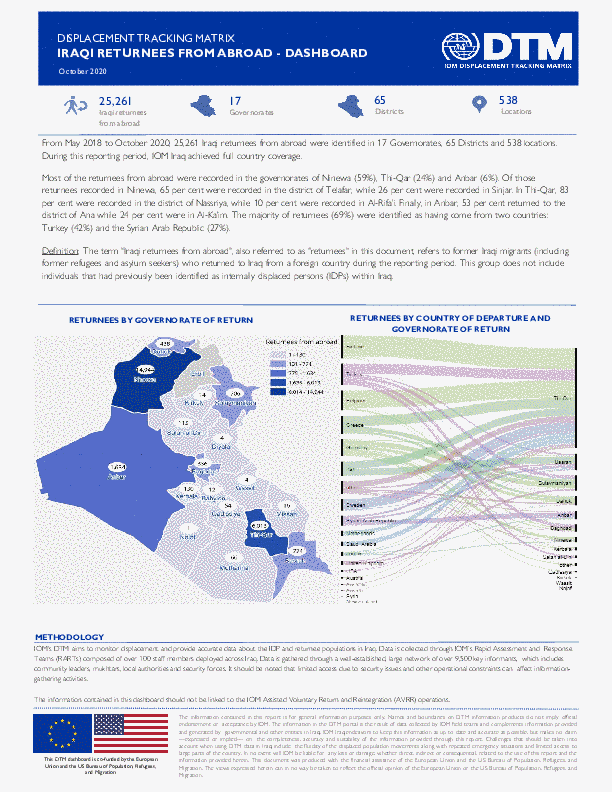
Contact
DTM Iraq, IraqDTM@iom.int
Language
English
Location
Iraq
Period Covered
May 01 2018
Aug 31 2020
Activity
- Mobility Tracking
- Baseline Assessment
From May 2018 to August 2020, 23,457 Iraqi returnees from abroad were identified in 16 Governorates, 61 Districts and 538 locations. During this reporting period, IOM Iraq achieved full country coverage. Most of the returnees from abroad were recorded in the governorates of Ninewa (63%), Thi-Qar (19%) and Anbar (7%). Of those returnees recorded in Ninewa, 65 per cent were recorded in the district of Telafar, while 26 per cent were recorded in Sinjar. In Thi-Qar, 80 per cent were recorded in the district of Nassriya, while 12 per cent were recorded in Al-Rifa'i. Finally, in Anbar, 53 per cent returned to the district of Ana while 24 per cent were in Al-Ka'im. The majority of returnees (73%) were identified as having come from two countries: Turkey (44%) and the Syrian Arab Republic (29%)
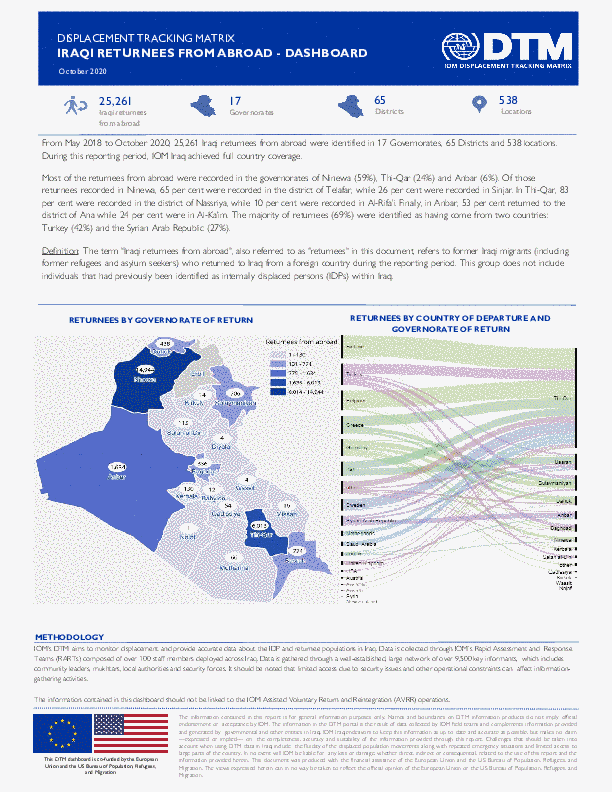
Contact
DTM Iraq, IraqDTM@iom.int
Language
English
Location
Iraq
Period Covered
May 01 2018
Oct 31 2020
Activity
- Mobility Tracking
- Baseline Assessment
From May 2018 to October 2020, 25,261 Iraqi returnees from abroad were identified in 17 Governorates, 65 Districts and 538 locations. During this reporting period, IOM Iraq achieved full country coverage. Most of the returnees from abroad were recorded in the governorates of Ninewa (59%), Thi-Qar (24%) and Anbar (6%). Of those returnees recorded in Ninewa, 65 per cent were recorded in the district of Telafar, while 26 per cent were recorded in Sinjar. In Thi-Qar, 83 per cent were recorded in the district of Nassriya, while 10 per cent were recorded in Al-Rifa'i. Finally, in Anbar, 53 per cent returned to the district of Ana while 24 per cent were in Al-Ka'im. The majority of returnees (69%) were identified as having come from two countries: Turkey (42%) and the Syrian Arab Republic (27%
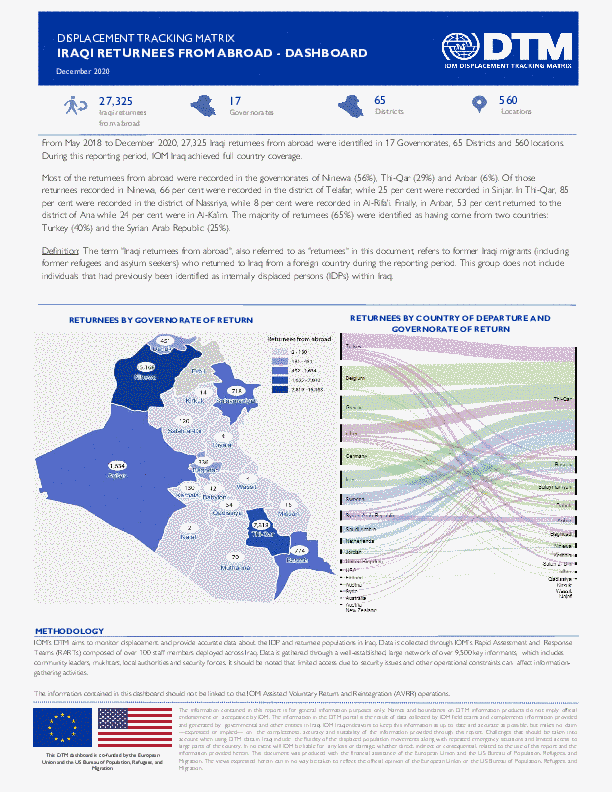
Contact
DTM Iraq, IraqDTM@iom.int
Language
English
Location
Iraq
Period Covered
May 01 2018
Dec 31 2020
Activity
- Mobility Tracking
- Baseline Assessment
From May 2018 to December 2020, 27,325 Iraqi returnees from abroad were identified in 17 Governorates, 65 Districts and 560 locations. During this reporting period, IOM Iraq achieved full country coverage. Most of the returnees from abroad were recorded in the governorates of Ninewa (56%), Thi-Qar (29%) and Anbar (6%). Of those returnees recorded in Ninewa, 66 per cent were recorded in the district of Telafar, while 25 per cent were recorded in Sinjar. In Thi-Qar, 85 per cent were recorded in the district of Nassriya, while 8 per cent were recorded in Al-Rifa'i. Finally, in Anbar, 53 per cent returned to the district of Ana while 24 per cent were in Al-Ka'im. The majority of returnees (65%) were identified as having come from two countries: Turkey (40%) and the Syrian Arab Republic (25%)
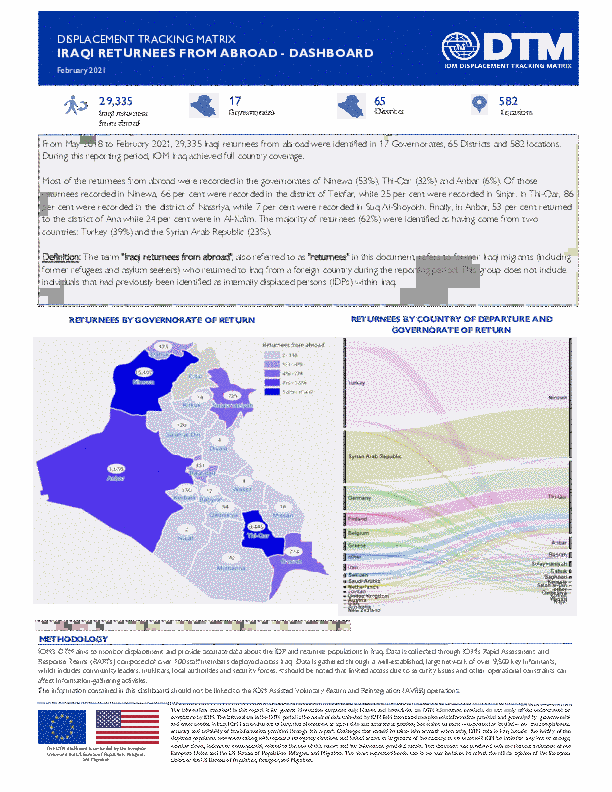
Contact
DTM Iraq, IraqDTM@iom.int
Language
English
Location
Iraq
Period Covered
May 01 2018
Feb 28 2021
Activity
- Mobility Tracking
- Baseline Assessment
From May 2018 to February 2021, 29,335 Iraqi returnees from abroad were identified in 17 Governorates, 65 Districts and 582 locations. During this reporting period, IOM Iraq achieved full country coverage. Most of the returnees from abroad were recorded in the governorates of Ninewa (53%), Thi-Qar (32%) and Anbar (6%). Of those returnees recorded in Ninewa, 66 per cent were recorded in the district of Telafar, while 25 per cent were recorded in Sinjar. In Thi-Qar, 86 per cent were recorded in the district of Nassriya, while 7 per cent were recorded in Suq Al-Shoyokh. Finally, in Anbar, 53 per cent returned to the district of Ana while 24 per cent were in Al-Ka'im. The majority of returnees (62%) were identified as having come from two countries: Turkey (39%) and the Syrian Arab Republic (23%)

Contact
DTM Iraq, IraqDTM@iom.int
Language
English
Location
Iraq
Period Covered
May 01 2018
Apr 30 2021
Activity
- Mobility Tracking
- Baseline Assessment
Between May 2018 and April 2021, a total of 31,212 Iraqi returnees from abroad were identified in 17 governorates, 66 districts and 590 locations. During this reporting period, IOM Iraq achieved full country coverage. Most of the returnees from abroad were recorded in the governorates of Ninewa (50%), Thi-Qar (36%) and Anbar (5%). Of those returnees recorded in Ninewa governorate, 66 per cent were recorded in the district of Telafar, while 25 per cent were recorded in Sinjar. In Thi-Qar governorate, 87 per cent were recorded in the district of Nassriya, while 7 per cent were recorded in Suq Al-Shoyokh. Finally, in Anbar governorate, 51 per cent returned to the district of Ana and 26 per cent returned to Al-Ka'im. The majority of returnees (60%) were identified as having come from two countries: Turkey (38%) and the Syrian Arab Republic (22%)
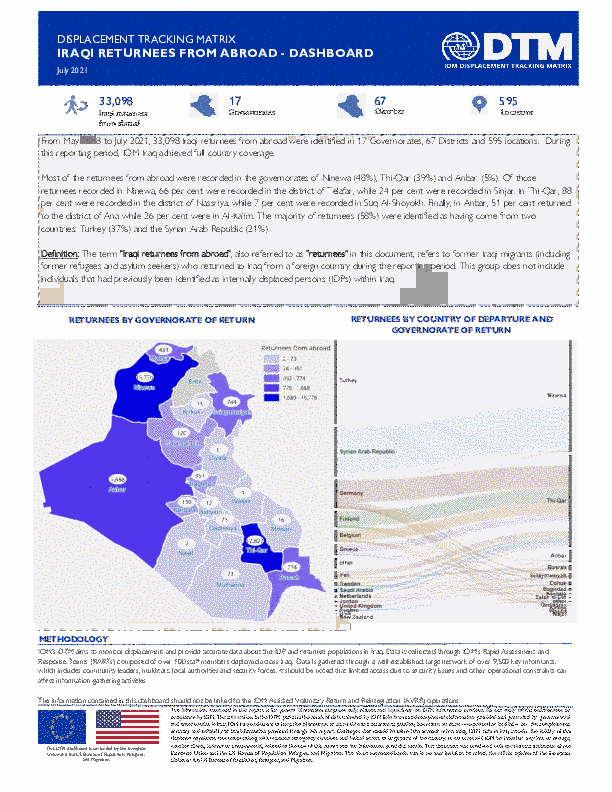
Contact
DTM Iraq, IraqDTM@iom.int
Language
English
Location
Iraq
Period Covered
May 01 2018
Jul 31 2021
Activity
- Mobility Tracking
- Baseline Assessment
From May 2018 to July 2021, 33,098 Iraqi returnees from abroad were identified in 17 Governorates, 67 Districts and 595 locations. During this reporting period, IOM Iraq achieved full country coverage. Most of the returnees from abroad were recorded in the governorates of Ninewa (48%), Thi-Qar (39%) and Anbar (5%). Of those returnees recorded in Ninewa, 66 per cent were recorded in the district of Telafar, while 24 per cent were recorded in Sinjar. In Thi-Qar, 88 per cent were recorded in the district of Nassriya, while 7 per cent were recorded in Suq Al-Shoyokh. Finally, in Anbar, 51 per cent returned to the district of Ana while 26 per cent were in Al-Ka'im. The majority of returnees (58%) were identified as having come from two countries: Turkey (37%) and the Syrian Arab Republic (21%).

Contact
DTM Iraq, IraqDTM@iom.int
Language
English
Location
Iraq
Period Covered
Mar 01 2016
Jun 30 2021
Activity
- Survey
- Community Perception
- Displacement Solutions
- Return Intention
- Mobility Tracking
- Baseline Assessment
What happens to households experiencing protracted displacement during a global pandemic? This is not a question that Access to Durable Solutions Among IDPs in Iraq, a panel study conducted by IOM and Georgetown University, initially anticipated answering at its inception six years ago.1 Yet this question is one the study is uniquely positioned to answer. The mixed-method project collects data from surveys and interviews to understand how the same Iraqi IDP households displaced by the conflict with the Islamic State in Iraq and the Levant (ISIL) try to access a “durable solution” to their displacement as defined by the Inter-Agency Standing Committee’s Framework on Durable Solutions. Conducted among the non-camp population of IDPs displaced between 2014 and 2015, the study operationalized the eight criteria that collectively measure a durable solution: safety and security, standard of living, livelihood, housing, access to documentation, family reunification, participation in public affairs, and access to justice. Using each of these criteria over six rounds of data collection, the study has tracked changes in what challenges IDP households face and the solutions they engineer as they search for a durable solution to their displacement. Based on findings from the newest, sixth round of data collection, this report details not only how COVID-19 affects IDPs, but specifically, and in keeping with the purpose of the study, how the COVID-19 pandemic affected IDP households’ abilities to achieve a durable solution. This latter endeavor entails two tasks: first, to identify what challenges persist because they existed pre-COVID-19 (and are thus primarily displacement-related), and second, to identify what challenges the COVID-19 pandemic has created or made worse. The longitudinal nature of the Access to Durable Solutions study and its ability to compare current findings with past trends using the same indicators facilitated disentangling and completing these two tasks

Contact
DTM Iraq, IraqDTM@iom.int
Language
English
Location
Iraq
Snapshot Date
Sep 30 2017
Activity
- Survey
- Community Perception
- Displacement Solutions
In order better to understand what the local integration of internally displaced persons (IDPs) may look like in Iraq, IOM Iraq, the Returns Working Group (RWG), and Social Inquiry implemented a targeted in-depth study in Sulaymaniyah and Baghdad Governorates. Utilizing data on IDPs’ perceptions and living conditions in displacement from those displaced more than three years (762 respondents) and data collected among host community residents (800 respondents) in the same neighbourhoods and towns in these governorates, this work seeks to identify which factors help or hinder local integration.
The findings presented herein highlight that socioeconomic, cultural, and spatial factors at the individual and structural levels matter for integration and acceptance. Most of the evidence collected here points to the fact that better integration and acceptance is found among more socioeconomically equal communities, those with strong but more elastic social cohesion, and in places where host communities feel historical grievances related to violence and conflict have been dealt with satisfactorily
Apr 22 2024
Print
Countries in this response
- Active DTM operation
- Past DTM operation

Contact
DTM Nigeria, iomnigeriadtm@iom.int
Language
English
Location
Nigeria
Period Covered
Apr 08 2024
Apr 14 2024
Activity
- Mobility Tracking
- Event Tracking
Between 8 and 14 April 2024, a total of 462 new arrivals were recorded at locations in Adamawa and Borno states. The new arrivals were recorded at locations in Askira/Uba, Bama, Gwoza, and Kala Balge Local Government Areas (LGAs) of the most conflict-affected Borno State, and in Fufore, Gombi, Hong, Madagali, and Michika LGAs of Adamawa State.
ETT assessments identified the following movement triggers: improved security (178 individuals or 38%), poor living conditions (124 individuals or 27%), family re-unification (88 individuals or 19%), seasonal farming (45 individuals or 10%), military operations (14 individuals or 3%) and fear of attack (13 individuals or 3%).
There was no movement recorded on 10 April 2024, as a result of the holiday marking the end of the Ramadan fast.